Last Updated on April 21, 2025 by Owen McGab Enaohwo
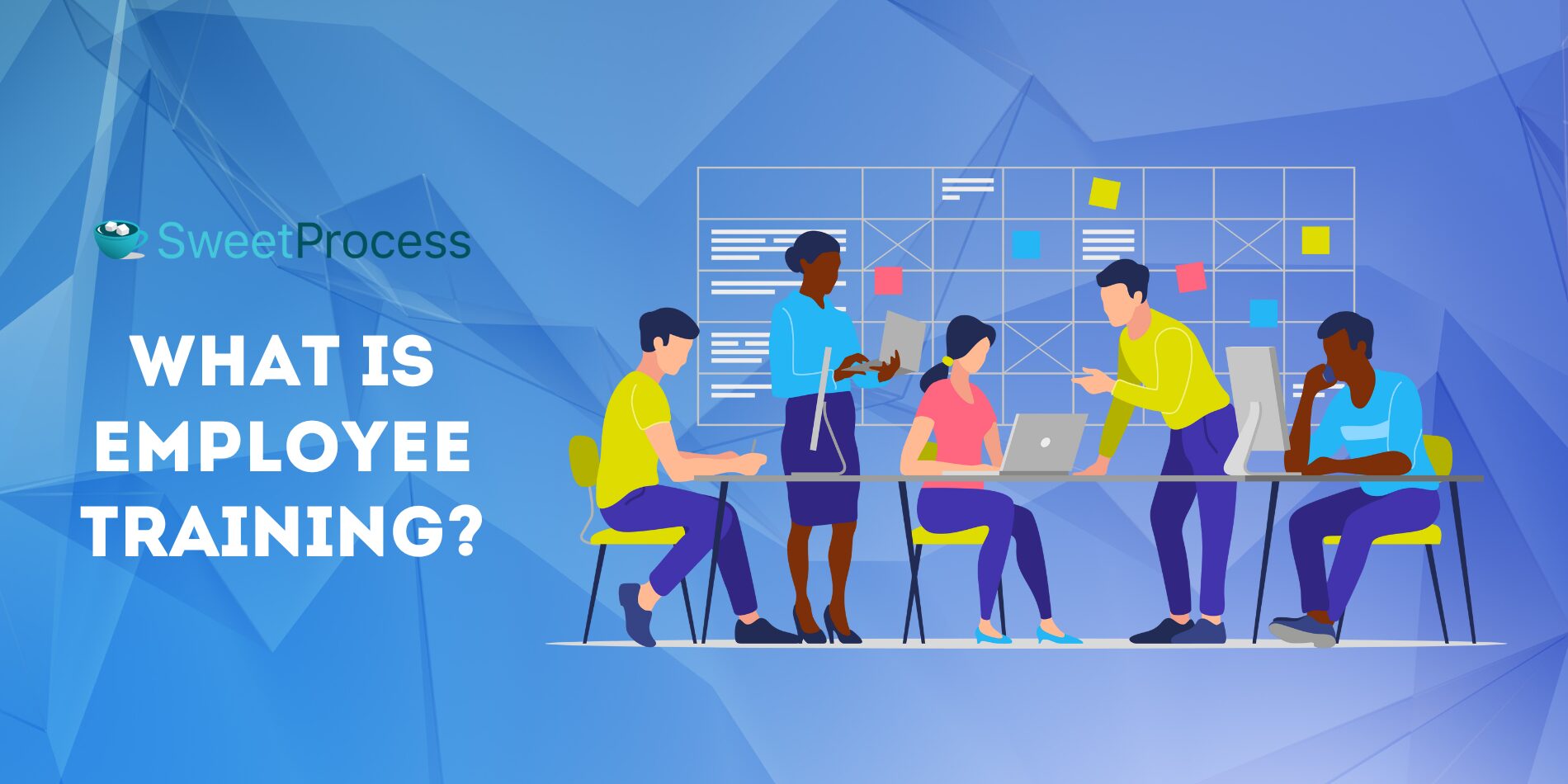
Businesses do not go bankrupt overnight. It is often a result of employee negligence.
A skilled employee base is an organization’s biggest asset. Cultivating a regular employee training culture drives business growth and sustainability. But how can organizations attain such heights? Implementing the right employee training software and practices makes the difference.
SweetProcess is an employee training software with easy-to-use features for remote and interactive training. Sign up for a 14-day free trial without a credit card.
What You’ll Learn In This Guide:
Why Employee Training Matters: 7 Benefits for Employers and Employees
11 Types of Employee Training Programs You Can Implement in Your Company
How to Train Your New Employees Effectively Using SweetProcess
5 Impressive Employee Training Examples You Can Copy
8 Tips and Best Practices for Effective Employee Training
7 Employee Training Trends for 2025 and Beyond
Train Your New Employees Effectively Using SweetProcess
Frequently Asked Questions (FAQs) About Employee Training
What Is Employee Training?
Organizations invest resources in hiring the best candidates from a pool of applicants who respond to their job vacancy posts. It is detrimental to the company for new employees to commence work without proper training. Proactive businesses leverage digital tools to streamline the training process. But what happens next after the initial training of new employees?
There is so much focus on training new employees that established ones are not given the same attention.
This is an operational blunder with dire consequences. Regular employee training is necessary to compete favorably in the ever-changing modern business environment.
Employee training is a deliberate effort to empower employees with the skills, knowledge, and resources to perform their duties effectively. It entails periodic evaluation of employee performance against industry standards and bringing them up to speed in areas where they underperform.
When employees are well-trained, it reflects in their jobs. In a SurveyMonkey research, 59% of employees affirm that good training improves their performance. The same cannot be said of undertrained employees, who may be out of touch with current standard practices.
In an instance where employee training was conducted on data management a year ago, introducing new data management regulations made the knowledge gained obsolete. It is in the organization’s best interest to retrain them on the subject lest they be prone to data-related offenses.
Maintaining excellence in the workplace is not a default setting but a collective organizational effort.
Businesses must prioritize employee training to succeed because it directly impacts performance and productivity. This begins with using a simple but effective tool like SweetProcess to facilitate learning.
Why Employee Training Matters: 7 Benefits for Employers and Employees
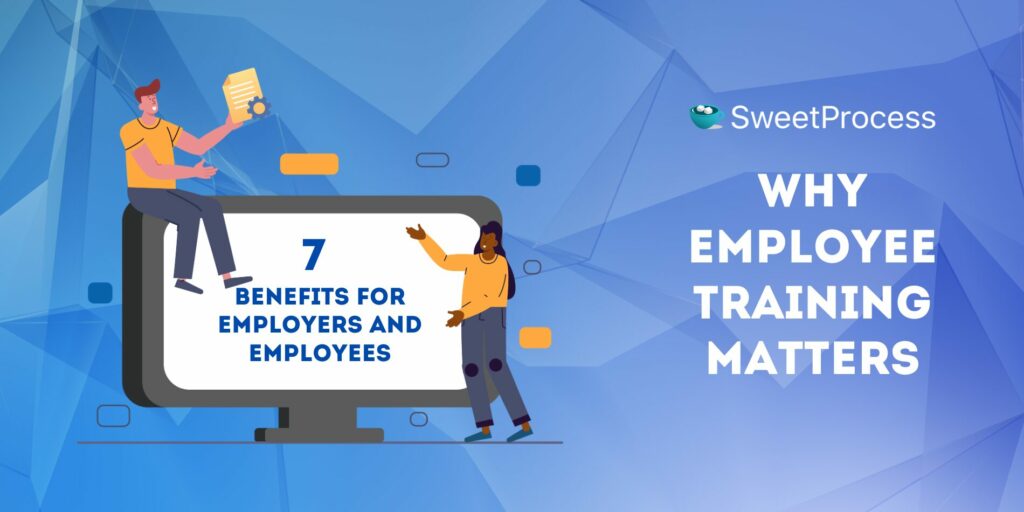
Employees sometimes find training unhelpful due to a lack of engagement and motivation. Organizations that overcome such barriers record positive results in their employees and the general work outlook.
Improves Employee Morale and Productivity
Employees’ attitudes to work precede their performance levels. A genuine interest in work sets the tone for increased employee productivity. Equipping team members with the skills boosts their morale and spurs them to deliver good results. Heightened employee morale leads to the accomplishment of more work.
Increases Employee Retention and Performance
Employees may question their job suitability when dissatisfied with their performance and seek satisfaction elsewhere. Such doubts often stem from a lack of resources to perform their duties. A LinkedIn study shows that 94% of employees would remain in organizations that invest in their training. Employee training enhances performance and increases retention, as employees will be interested in remaining on the job due to satisfaction.
Equips Employees With Up-to-Date Skills
Problem-solving is a criterion for measuring employee efficiency. The most competent employees lose value when their skills become outdated. Regular employee training helps keep them at the top of their game, and utilizing Employee Handbook Software ensures that training materials and policies are always accessible and current. A lack of training causes expertise decline and a devaluation of an organization’s currency. Adequate training enhances low-performing employees’ skills, creating a level playing field in the workplace.
Boosts Company Profile and Reputation
Recent studies show that companies lose about 30% of their capabilities yearly due to a lack of employee training. An organization’s employee pedigree impacts its profile and reputation. Companies with highly skilled employees command the biggest clients and deals due to heightened confidence in their ability to deliver good results. Organizations seeking such a reputation can work their way up by training their employees and leaving no room for mediocrity.
Helps to Attract Top Talent
High-performing employees are drawn to businesses that nurture their skills for higher performance. They may be compelled to look elsewhere after sensing an organization’s reluctance to facilitate their professional development. Organizations with a robust training system as an incentive stand a better chance of attracting the best talents in the business.
Builds an Internal Talent Marketplace
Organizations can increase employee retention rates by building a strong internal talent base that allows employees to grow and transition into other roles. This can be achieved by providing extensive training on a vast area of expertise and encouraging employees to try out befitting roles. The availability of skilled hands saves companies the time and financial resources needed to fill emerging positions with external talents.
Cultivates a Positive Organizational Culture
The quality of an organization’s employees reflects its values, culture, and general work ethic. It is natural for employees to excel in areas they are regularly trained in. For instance, a company that emphasizes mutual respect in its training will ultimately have a team that respects one another. Recurring elements in employee training make up the organizational culture, yielding positive outcomes when done in good faith.
There may be a disparity in organizational culture between new and established employees.
You can try out SweetProcess for 14 days to build your company’s knowledge base and educate employees about company culture, regardless of their positions.
11 Types of Employee Training Programs You Can Implement in Your Company
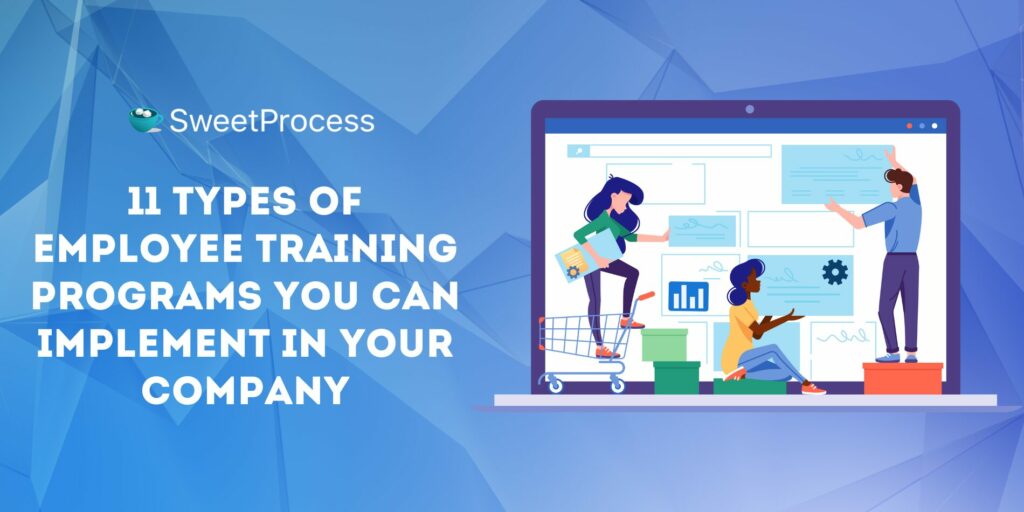
Training mismatch contributes to employee training failure. Rather than conducting training as a formality, organizations can meet employees’ skill needs by identifying and implementing the most suitable training at the right time.
Onboarding Training
Onboarding training is arguably the most common employee training. As new team members join an organization, they naturally need to get acquainted with its culture, operations, and their responsibilities. This is usually the first training employees have in an organization, setting the tone for their performance.
Technical or Skill-Based Training
Technical or skill-based training addresses the specific skills employees need to perform their duties. Skill level determines the quality of employees’ performance or output. Organizations have a role to play in determining their workers’ abilities. Providing skill-based training sharpens current skills and promotes expertise. Front desk personnel and an accountant may undergo the same training in some areas, but their technical training must differ due to their unique responsibilities.
Soft Skills Training
Employees with good technical skills may excel in practical tasks but need more soft skills to collaborate with others. For instance, lacking the skills to communicate effectively with team members could jeopardize operations. Soft skills training helps teammates maximize their technical skills and contribute to a healthy work culture.
Compliance Training
Compliance training acquaints employees with the legal and regulatory job requirements. Compliance risks may differ according to roles, but the smallest risks have a ripple effect across the entire organization. All team members should be trained on compliance requirements to prevent any loose ends.
Leadership and Management Training
An organization’s leadership and management culture dictates its work ethic and culture. A standard leadership and management training framework ensures senior staff members have the same work ethic. This creates uniformity in the company’s operations regardless of the different departments or teams.
Cross-Functional Training
Specialization promotes job expertise. However, the dynamics of the modern workforce call for versatility and flexibility. Cross-functional training is training employees in roles similar to their specialization. This promotes collaboration across departments and empowers workers to assume new emergency positions.
Diversity, Equity, and Inclusion (DEI) Training
Workplace diversity and inclusivity have never been more pronounced. They help organizations build a favorable image that attracts more business opportunities. Equity thrives better with an inclusive and diverse workforce. It eradicates racial, cultural, and religious biases, treating all employees fairly regardless of their origin and status.
Product Training
Product training makes employees experts in specific products by enriching their knowledge about the products’ features, use cases, benefits, and conditions. Employees can then effectively promote such products to customers, winning their trust and facilitating favorable buying decisions.
Safety Training
Employee safety should be at the top of an organization’s priorities. This is best implemented as an ongoing practice to acquaint workers with associated risks and their prevention strategies. A cohesive safety training educates employees about all risk components and effective ways to prevent them before they escalate.
Upskilling
Upskilling is specialized training that equips employees with new and more efficient skills to perform their jobs better. It examines employees’ current duties and seeks training opportunities to enhance their performance, saving time and resources.
Reskilling
Reskilling is the process of empowering employees with new skills for different roles within an organization. Unlike upskilling, which focuses on enhancing performance in current roles, reskilling empowers team members with new skills to assume new roles within the company. Reskilling helps organizations look inward for talent and fill vacancies at their convenience without looking for external candidates.
The efficiency of these employee training programs lies in high engagement.
How to Train Your New Employees Effectively Using SweetProcess
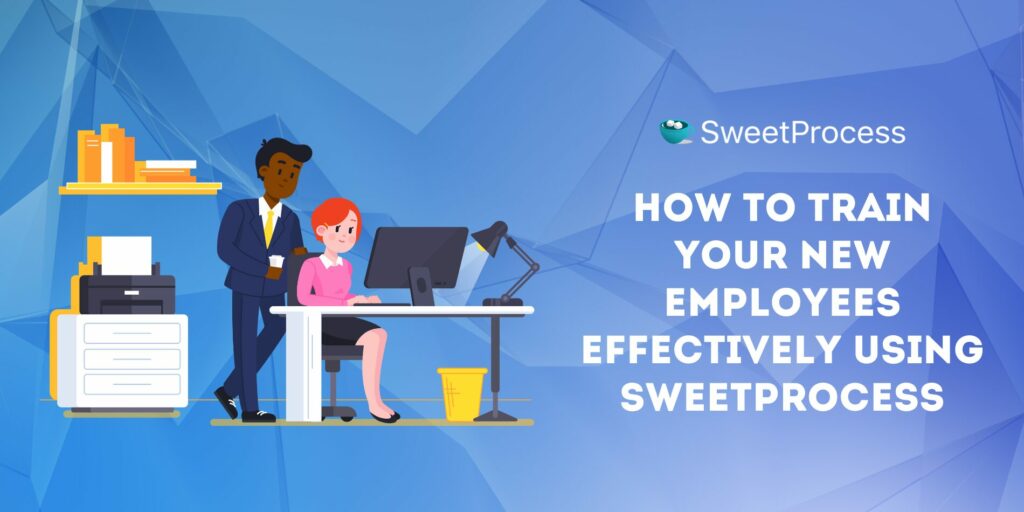
The influx of employee training documentation software indicates businesses need to train their workers. However, only a few deliver on their promises to streamline training for best results, and SweetProcess is at the top of the list.
Designed for organizations of all sizes, SweetProcess allows businesses to train their employees with standard operating procedures (SOPs), policies, and processes. Its cloud storage provides enough room to document information for remote access.
SOP Creation and Management in SweetProcess
Standard operating procedures (SOPs) are one of SweetProcess’s unique selling propositions. The system is designed to build a comprehensive workflow with step-by-step instructions on actions. SweetProcess SOPs include business procedures and processes for daily tasks within an organization, enabling consistency across boards.
Florida-based motion design company AEJuice is one of the many organizations that have streamlined new employee training with SweetProcess. Its chief executive officer (CEO), Jacob Syrytsia, describes the company’s initial training process as “pretty painful” because he had to explain things to new hires over and over again. Even after documenting the organization’s procedures and processes, his employees still had questions. But all of that changed when he implemented SweetProcess. Employees could learn all they needed to know by watching the documentation in SweetProcess.
“With SweetProcess, I’m able to take a vacation. I don’t have to be there all the time,” Jacob says. He trusts his employees to deliver great results in his absence because of SweetProcess—something he could not do before.
How to Create a Procedure Manually in SweetProcess
Click on “Procedures” and “Create Procedure.”
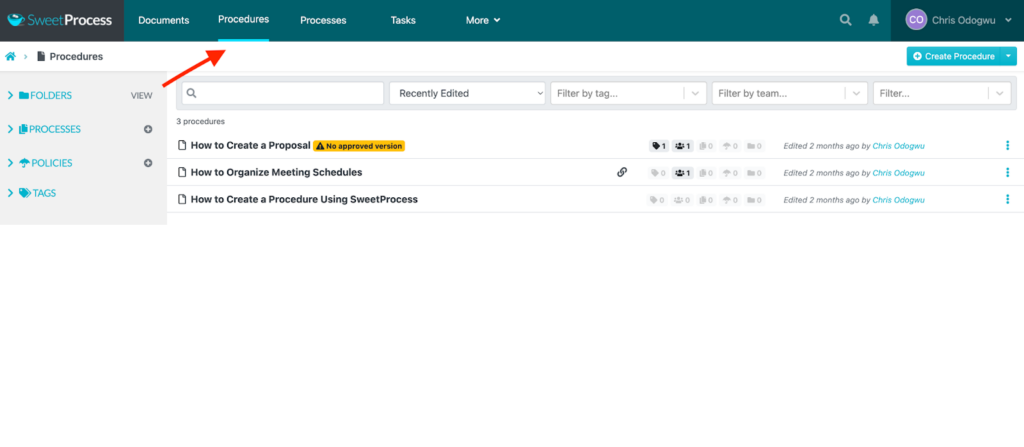
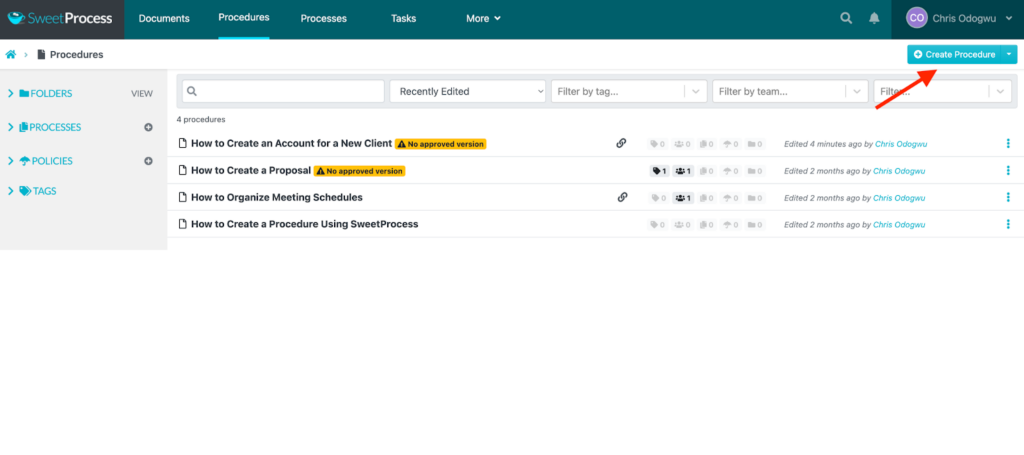
Enter the procedure title and click on “Continue.”
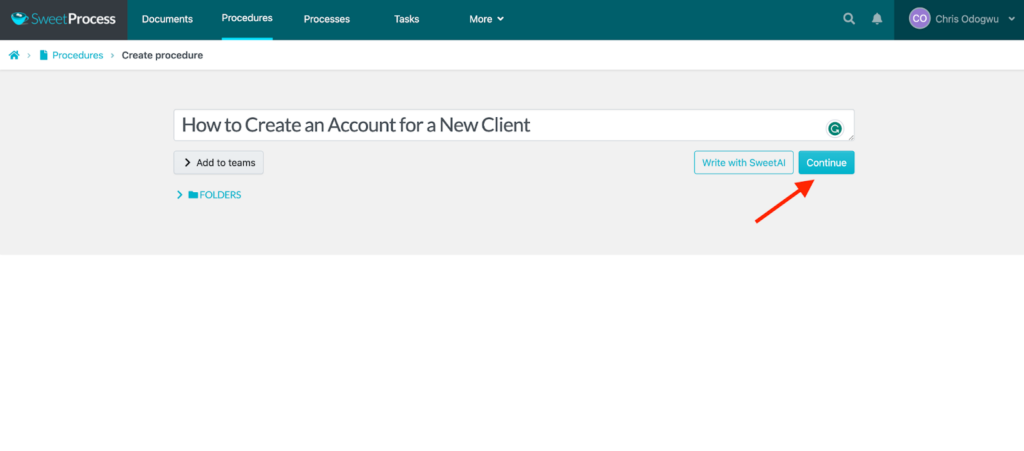
Click on the pencil icon beside the title.
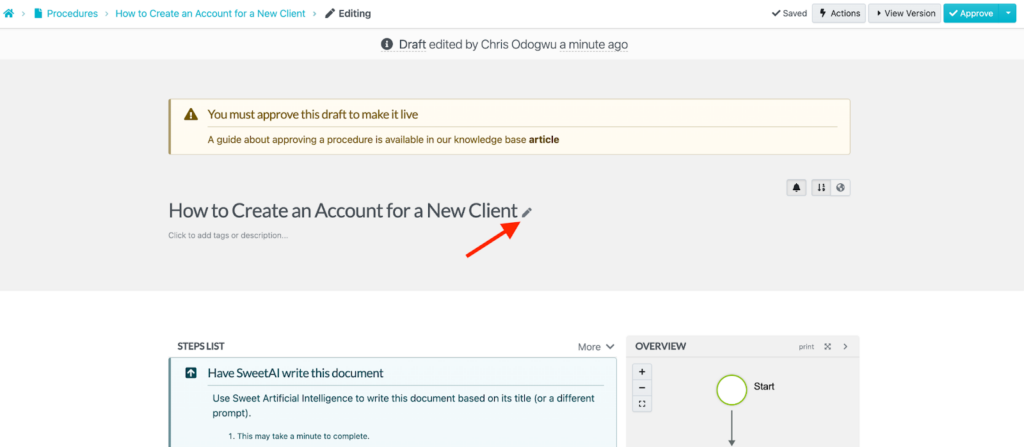
Enter the procedure details and click on “Finished Editing.”
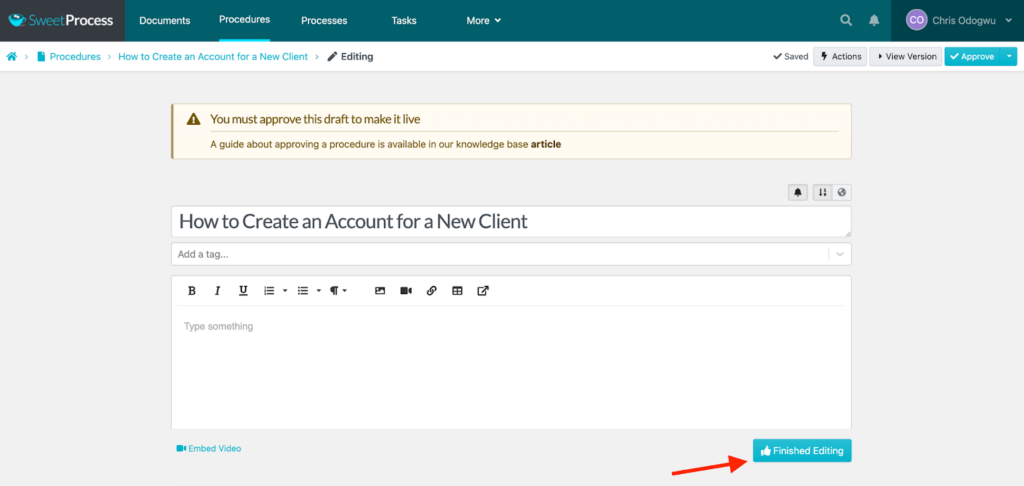
How to Create a Procedure in SweetProcess Automatically With SweetAI
Click on “Procedures” and “Create Procedure.”
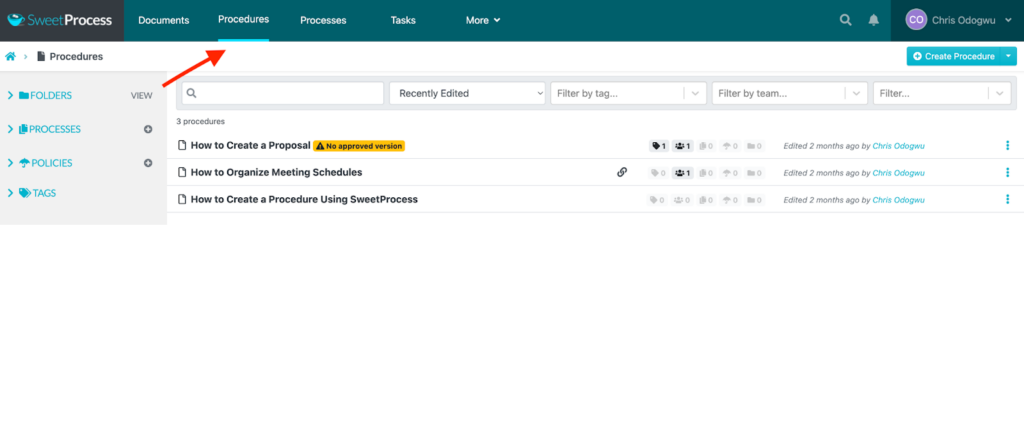
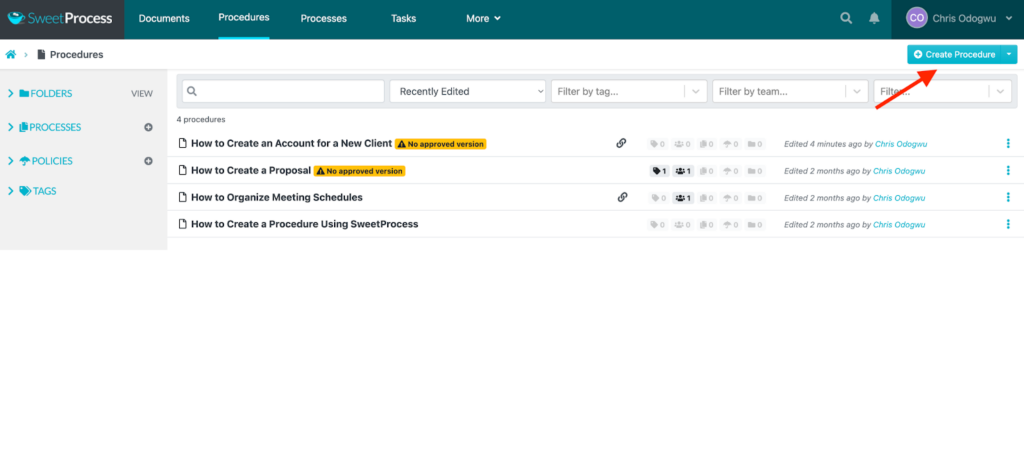
Enter the procedure title and click on “Write with SweetAI.”
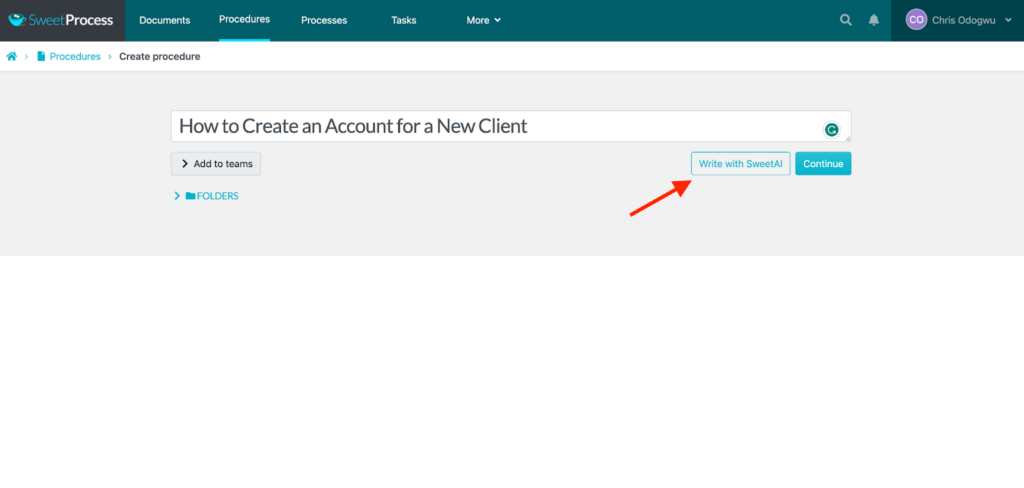
Click on the pencil icon to edit the content.
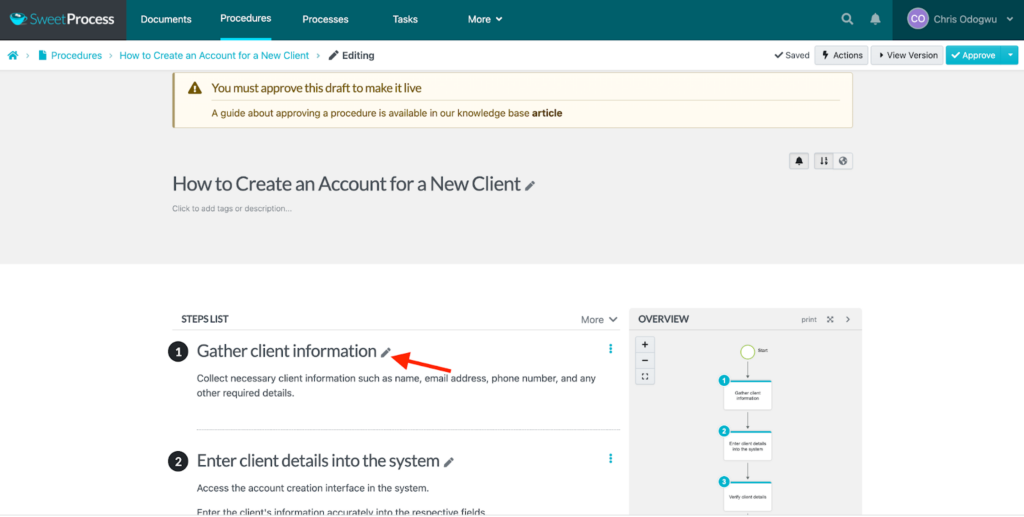
Click on “Approve” to publish the document.
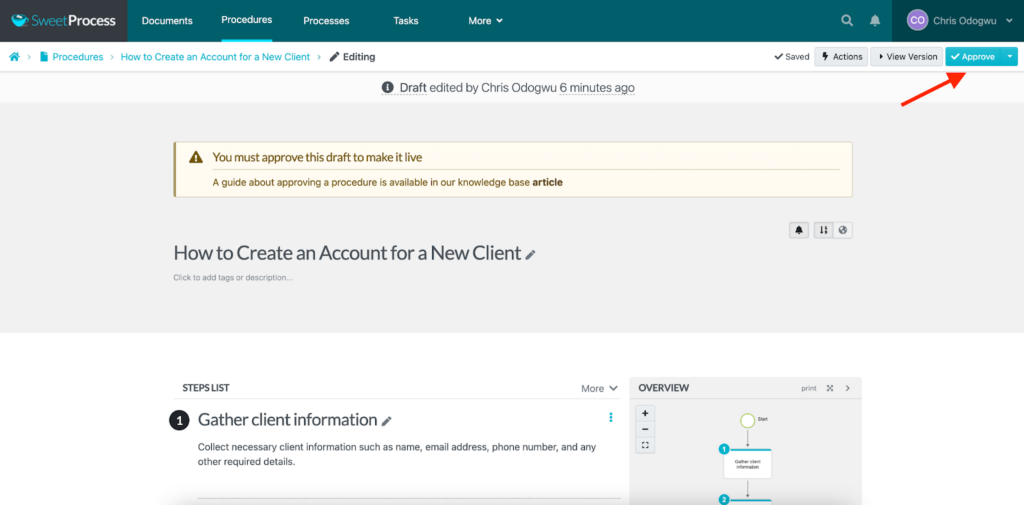
How to Document a Process in SweetProcess
Click on “Processes” and “Create Process.”
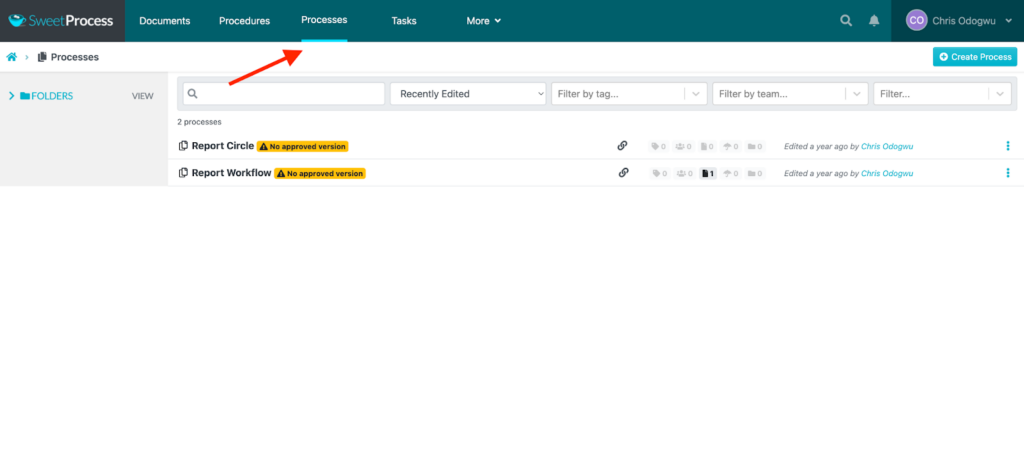
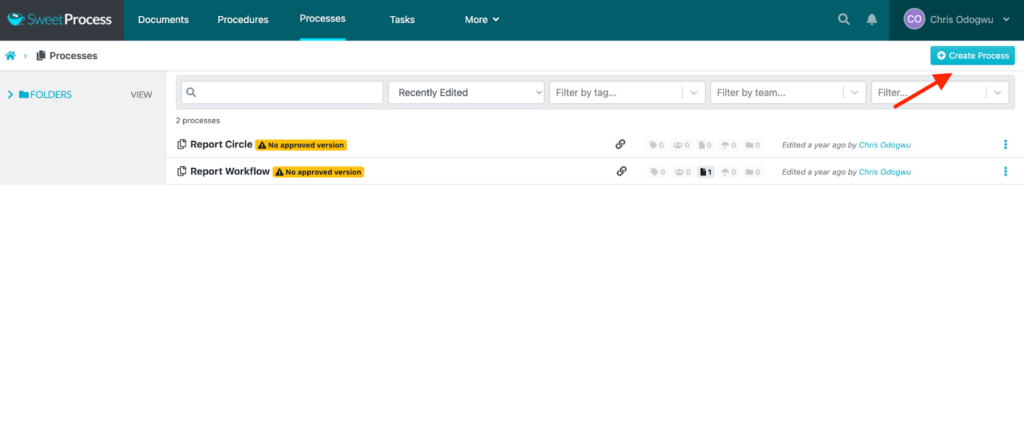
Enter the process title and click on “Continue.”
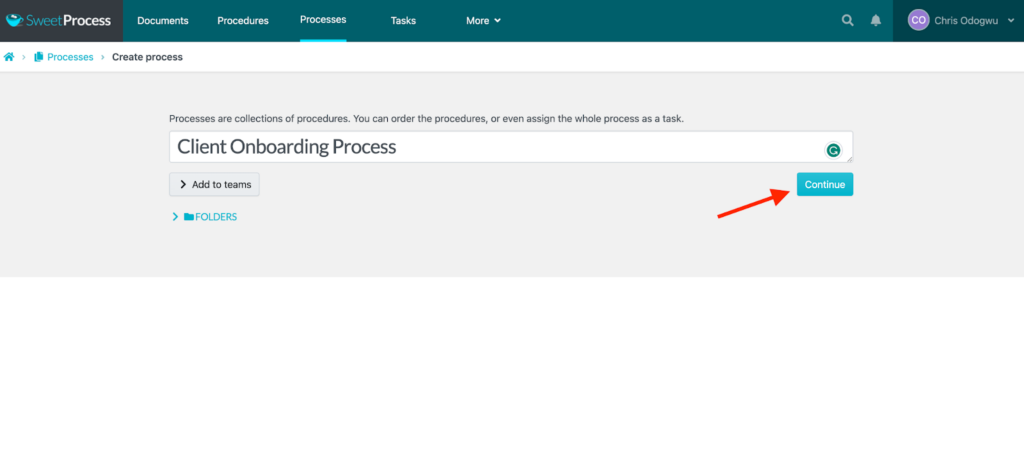
Click on “Add Step.”
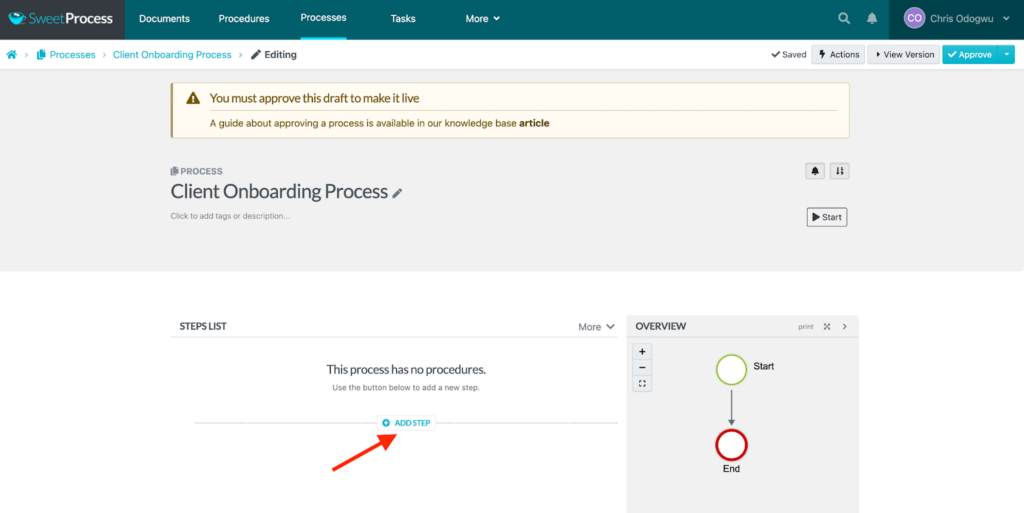
Click on “Procedure.”
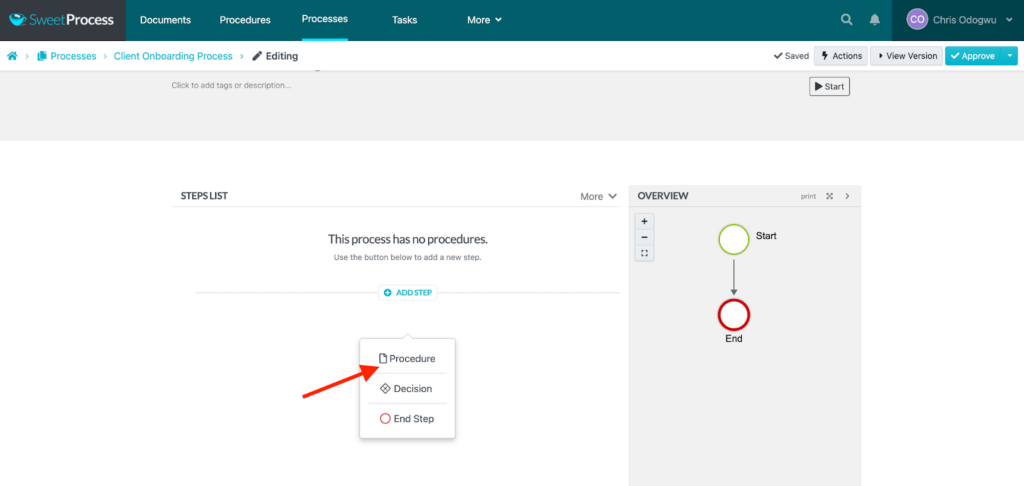
Choose the procedure from the menu.
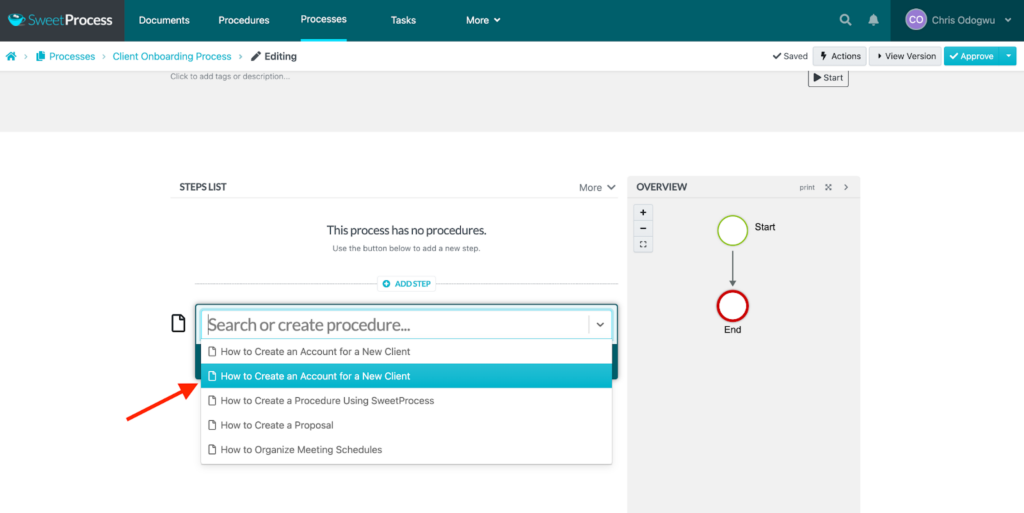
Click on “Add Step” and “Procedure” to add a step in the process.
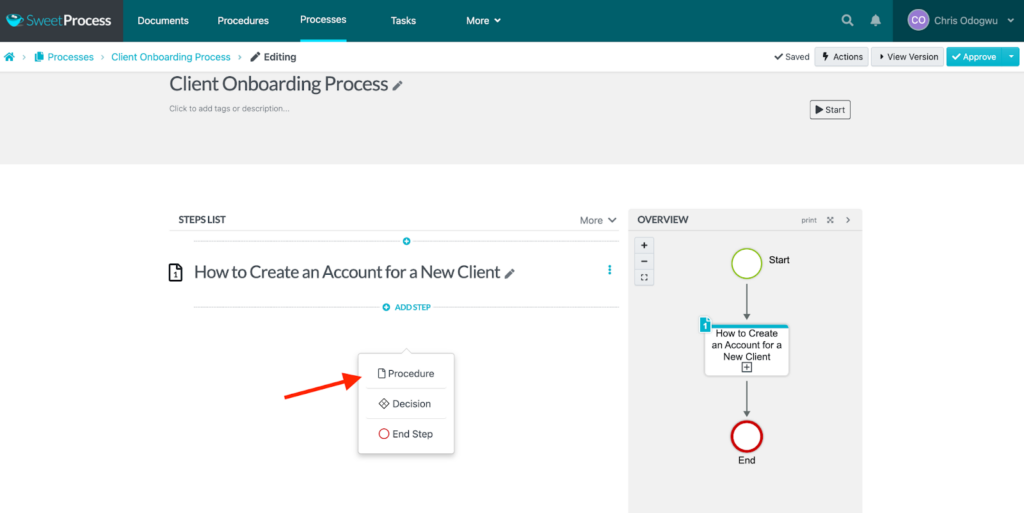
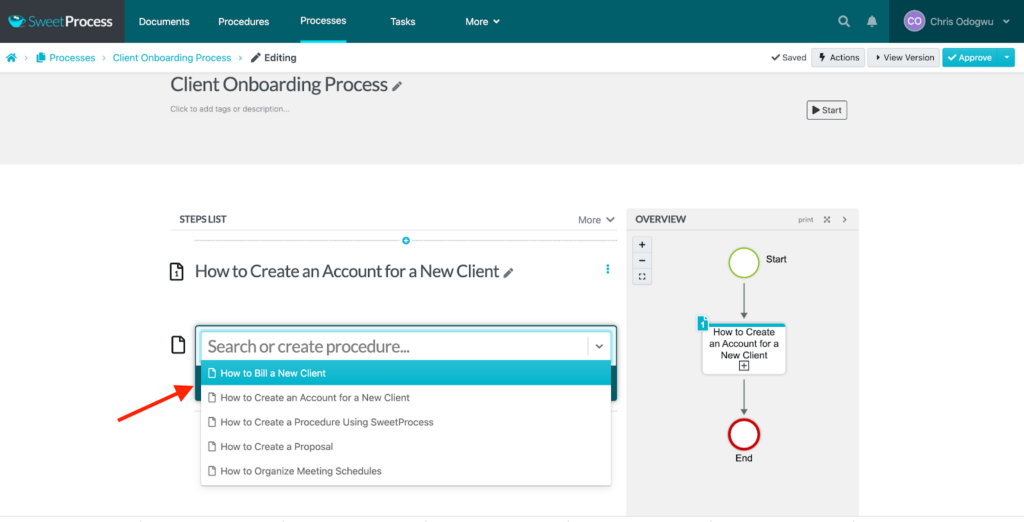
Click on “Approve” to publish your process.
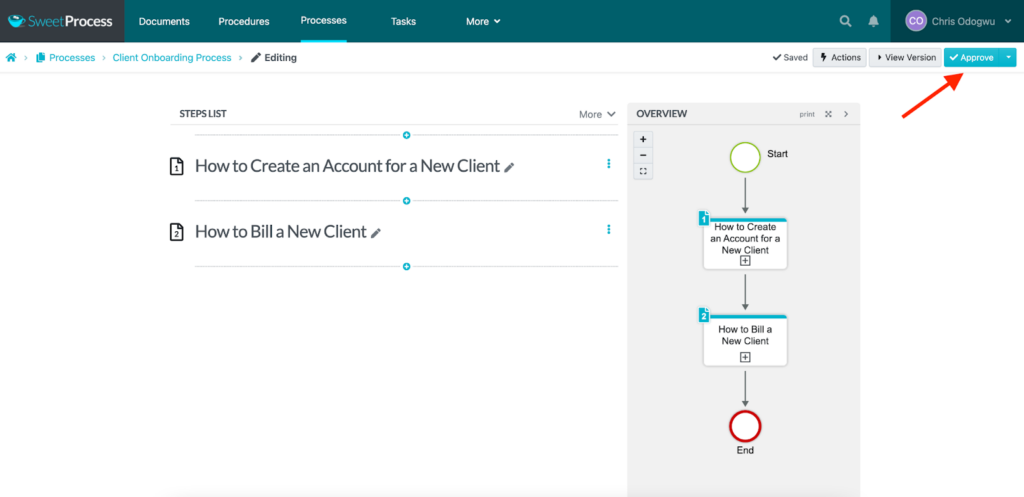
Policy Writing and Management in SweetProcess
Policies are the guiding principles of business. The do’s and don’ts keep employees in line with regulatory standards. As a policy writing software, SweetProcess’ policy management feature enables users to document, update, and share policy manuals with team members easily. As an alternative to manually creating policies, they can be created automatically with AI.
How to Create and Manage Policies in SweetProcess
Click on “More” and “Policies.”
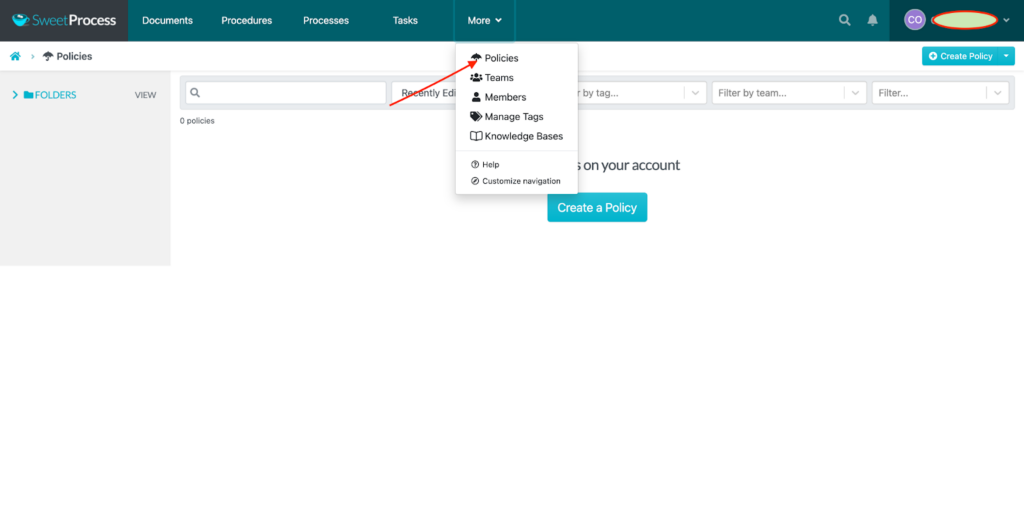
Click on “Create Policy.”
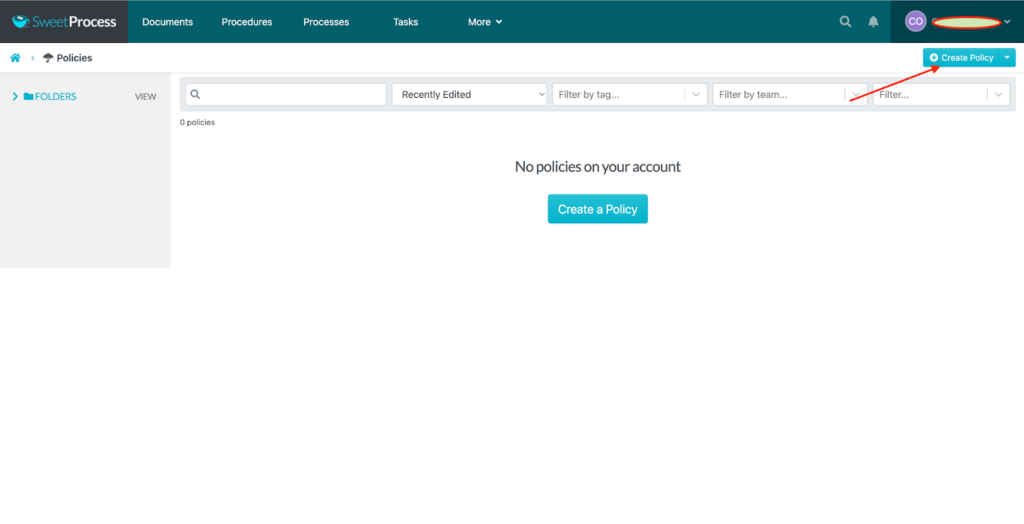
Enter the policy title.
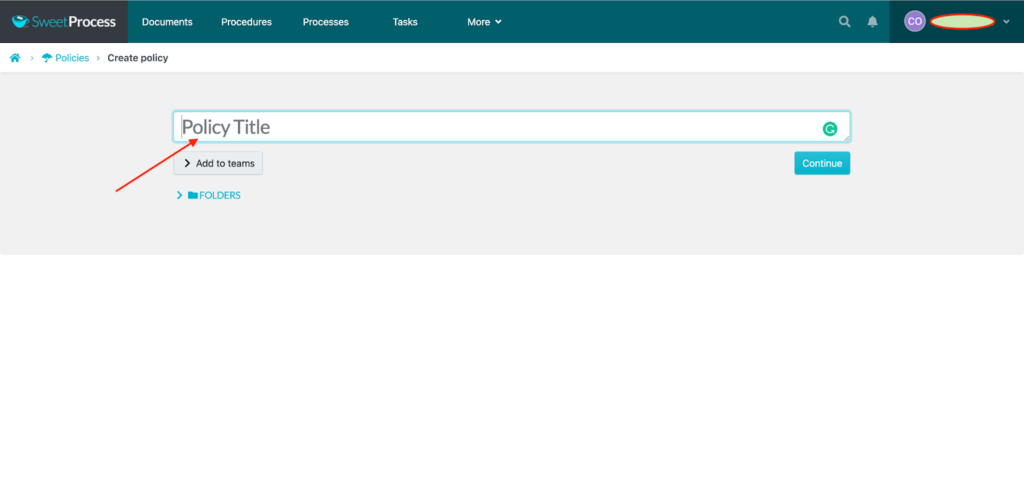
There is an option to import policy documents into SweetProcess.
Click on “More” and “Policies” from the drop-down menu.

Click on the button next to “Create Policy.”

Click on “Upload Document.”

Select the file on your computer.
Click “Add to teams” to share the policy with team members.

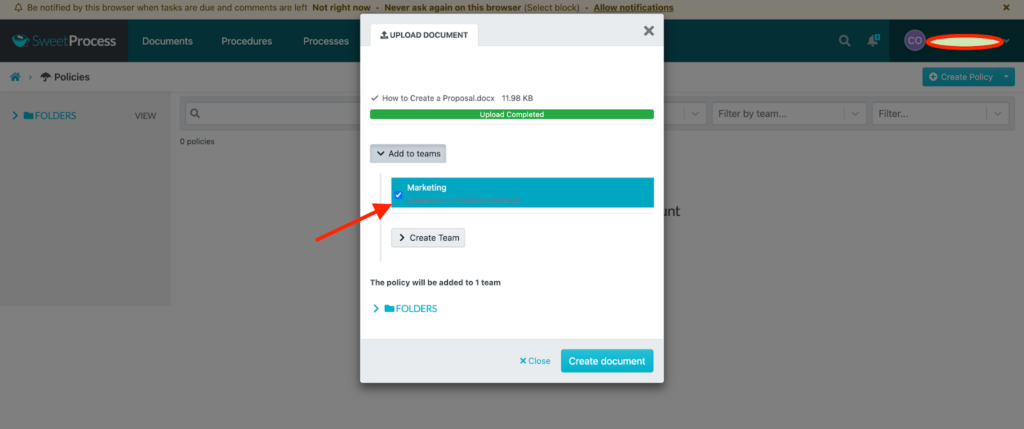
Click on “View Policy” to view the file when it uploads.

Click on “Edit” to modify the document if you want.
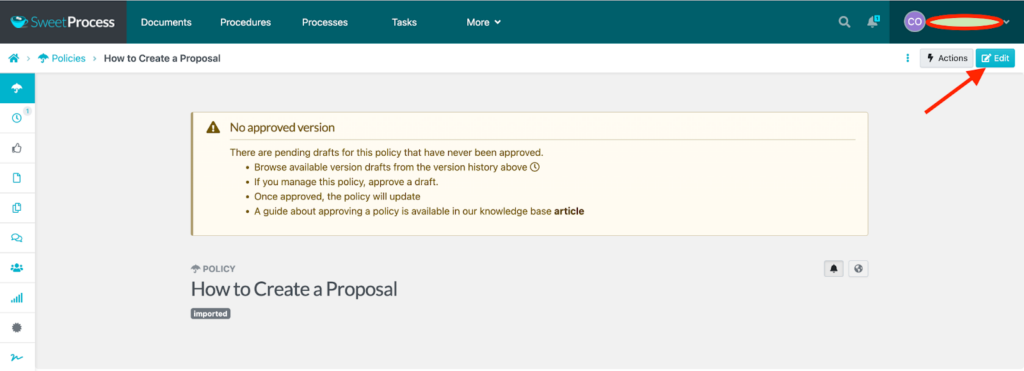
Click on “Approve” to publish the document or “Request Approval” to get approval from a team member.
Knowledge Base Creation and Management in SweetProcess
SweetProcess offers a knowledge base feature for businesses to create and store intellectual property. The documents are secure, as only authorized users can access them. The knowledge base facilitates employee training by providing team members with information at any time. In addition to creating internal knowledge bases for staff, organizations can also create external knowledge bases for external parties such as clients and the public.
Quality assurance and sensory coordinator at Stone & Wood, Tom Iacono, was amazed at how creating a knowledge base in SweetProcess transformed their operations. They struggled to follow due process and get standard regulatory certifications like the International Organization for Standardization (ISO), which was challenging because they did not have documented procedures and processes. However, business operations improved when they started documenting “need-to-know” in SweetProcess.
“We started using SweetProcess for what we call need-to-know. Things that we want to ensure people are across, we put those communications into SweetProcess.” In no time, there was consistency across the entire organization as employees had access to the same business procedures and processes in SweetProcess.
How to Create an Internal Knowledge Base in SweetProcess
Click on “More” and “Knowledge Bases.”
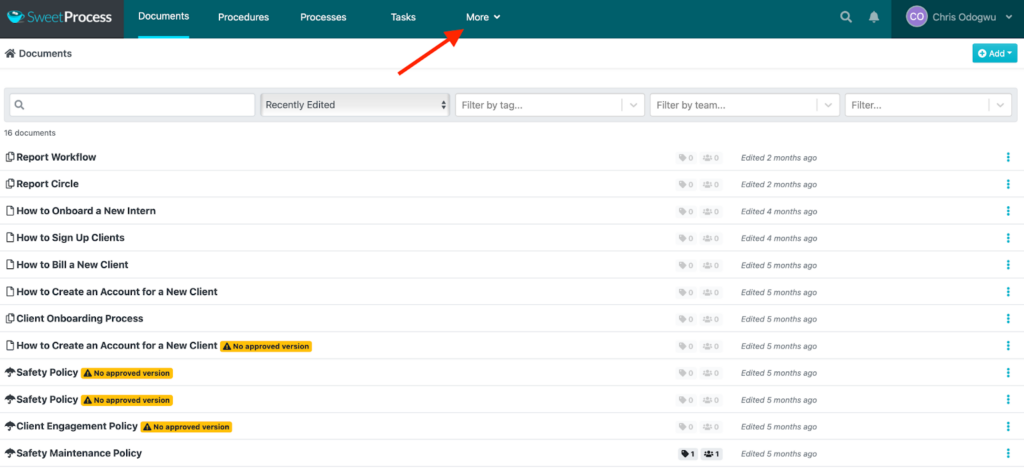
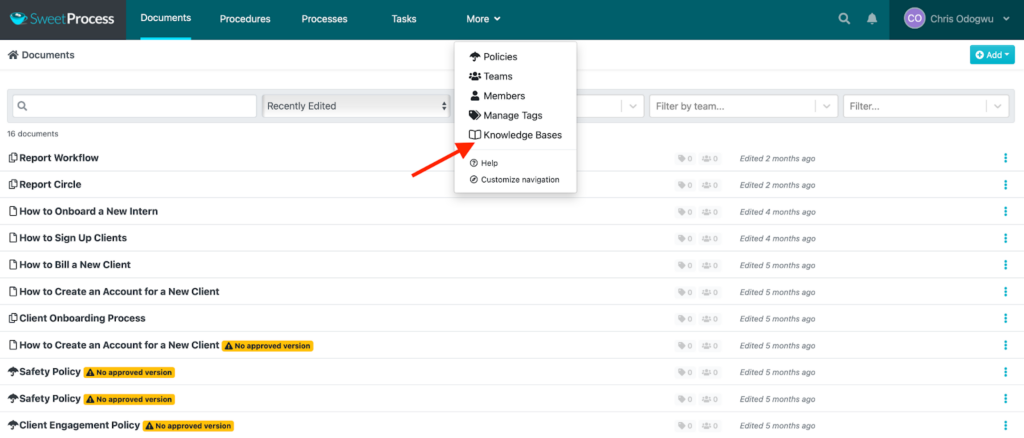
Click on “Create Knowledge Base.”
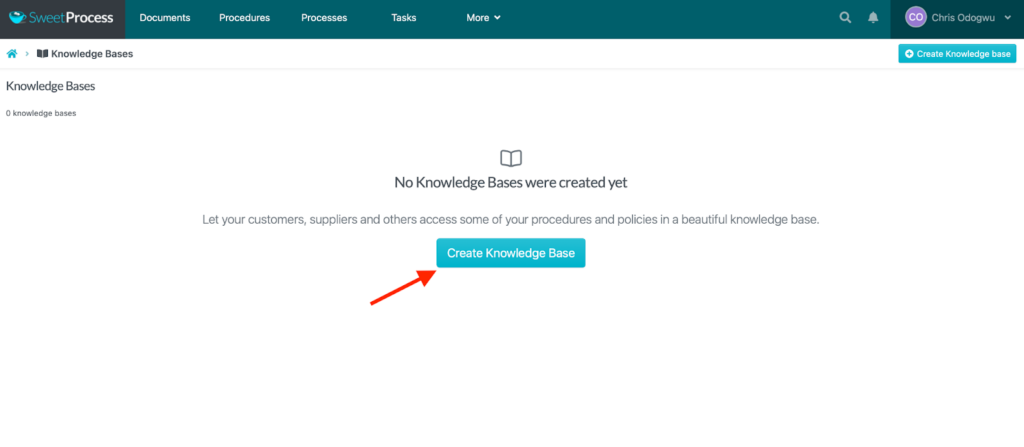
Enter the knowledge base title and click on “Continue.”
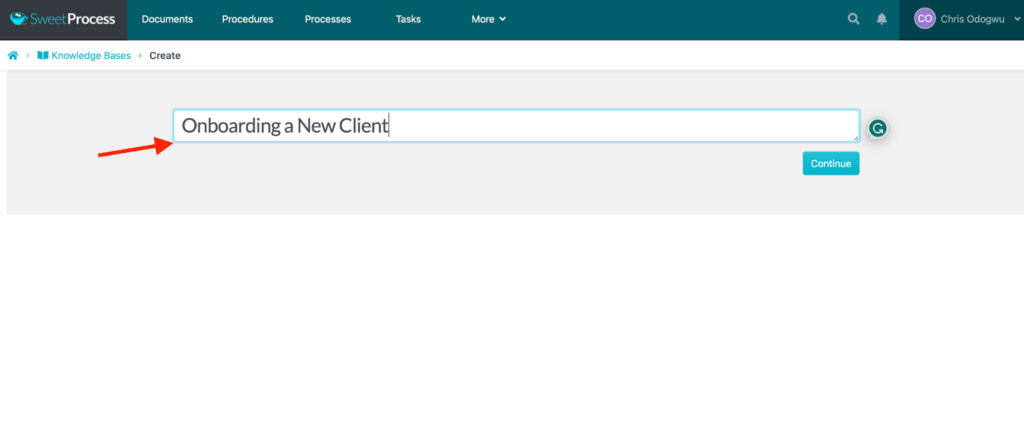
Click on the pencil icon beside the title.
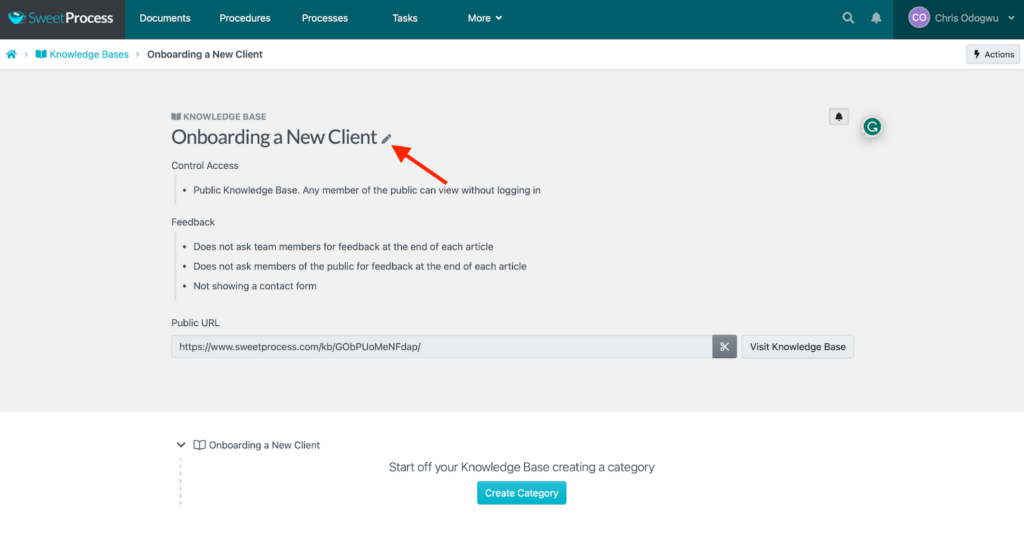
Click on the row below “Control Access” and select “Private Knowledge Base, only logged-in team members may view (if they have the necessary permissions).”
Enter the URL of the page that users will be redirected to when they click on the knowledge base title.
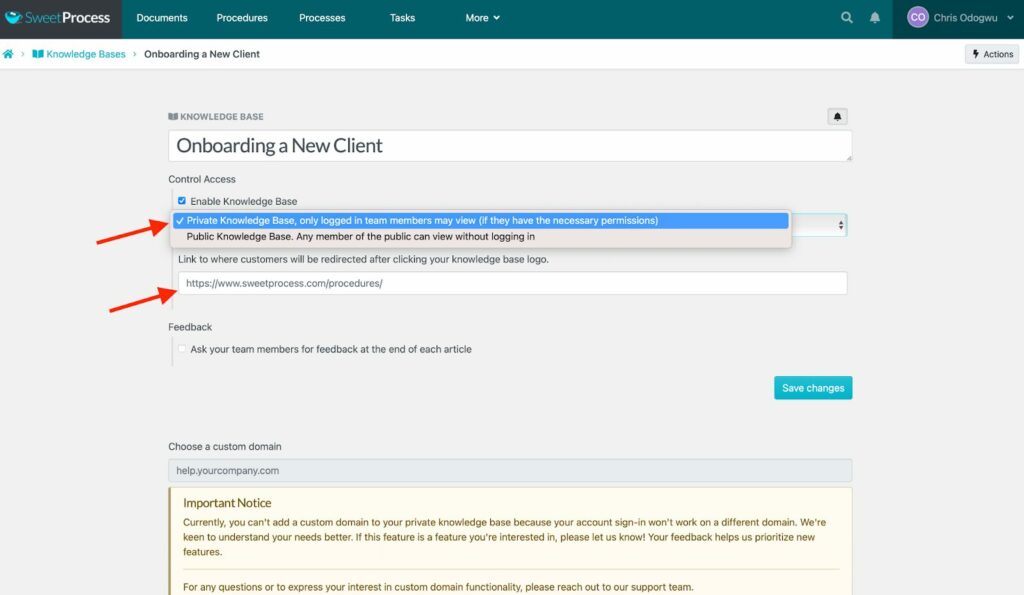
How to Create an External Knowledge Base in SweetProcess
Click on “More” and “Knowledge Bases.”
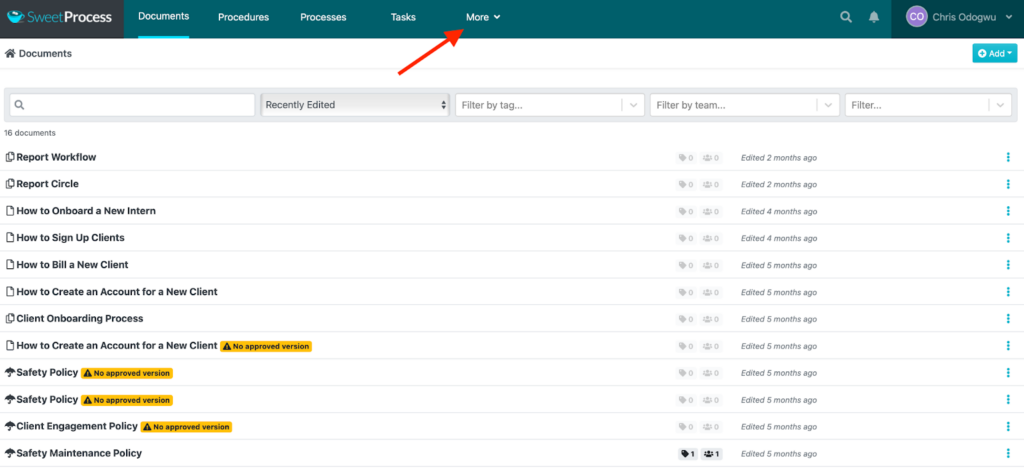
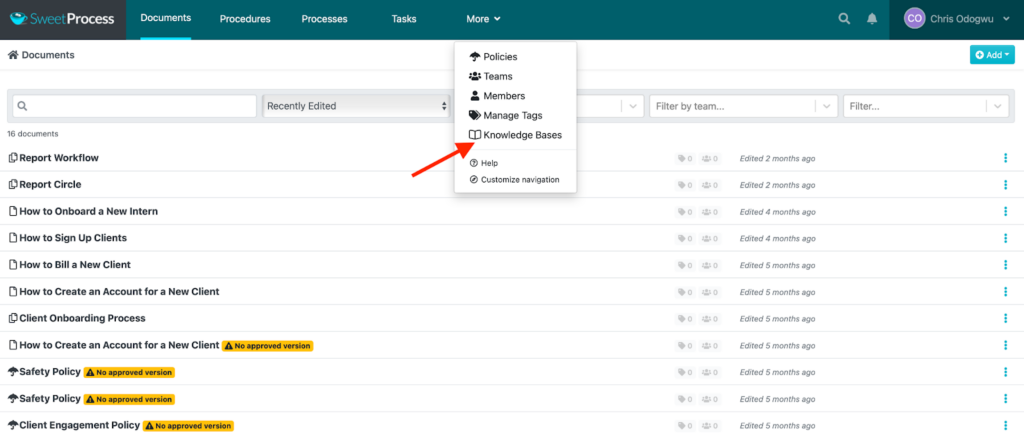
Click on “Create Knowledge Base.”
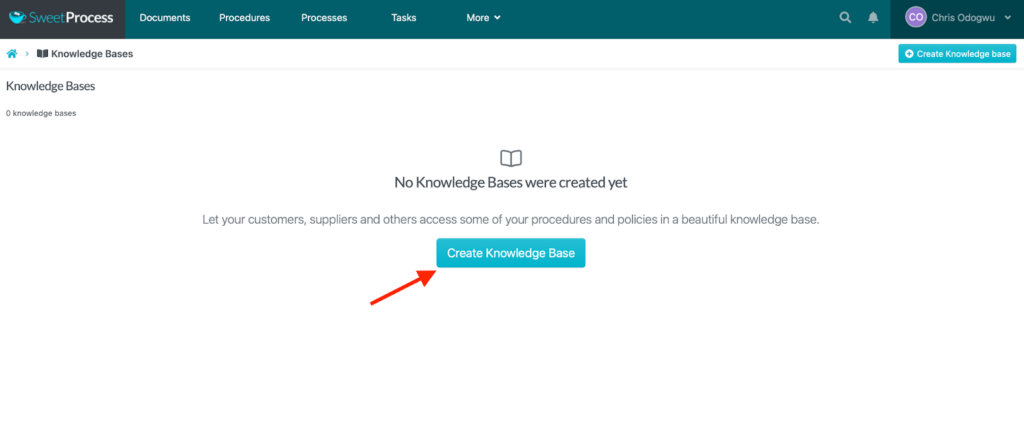
Enter the knowledge base title and click on “Continue.”
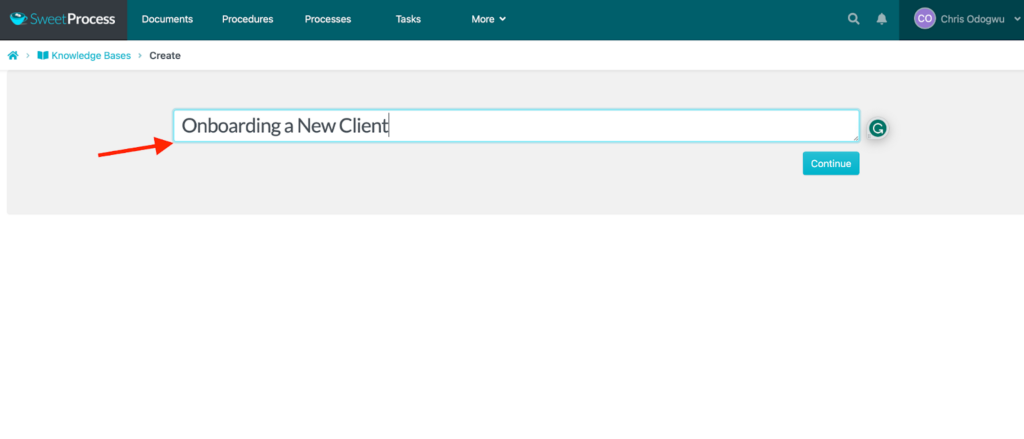
Click on the pencil icon beside the title.
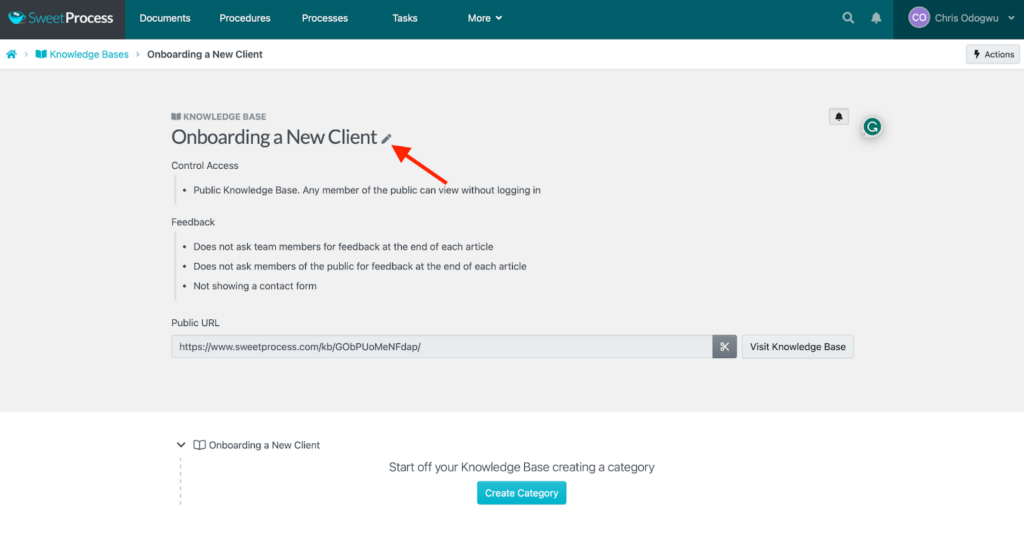
Click on the space bar below “Control Access” and select “Public Knowledge Base. Any member of the public can view without logging in.”
Enter the URL of the page that users will be redirected to when they click on the knowledge base title.

You may redirect users to a custom domain.
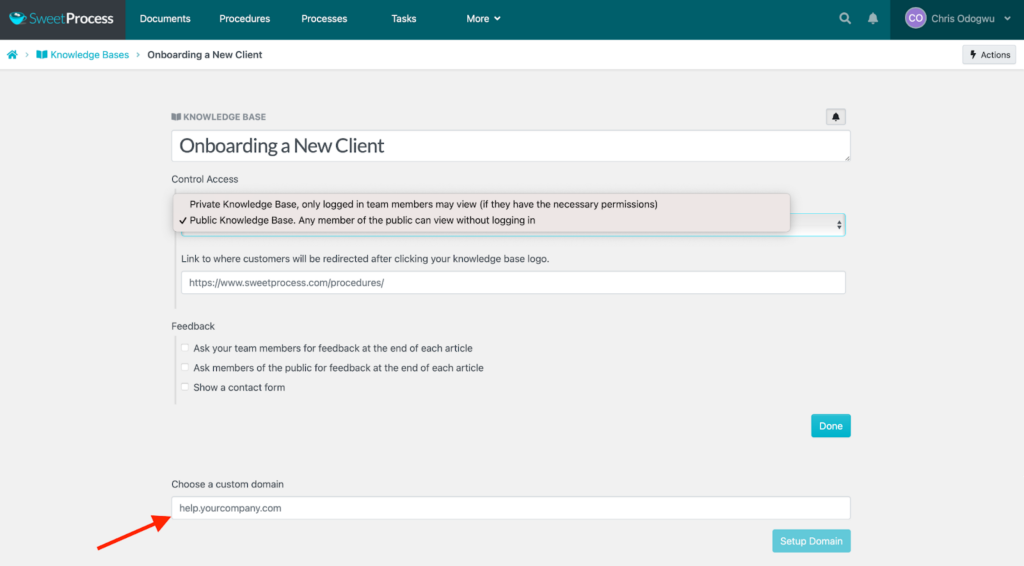
Task Management in SweetProcess
SweetProcess facilitates interactive employee training by allowing organizations to assign tasks and quizzes to training participants. This tool is useful for delegating work to team members and tracking progress.
How to Manage Tasks in SweetProcess
Navigate to the document and click “Actions.”
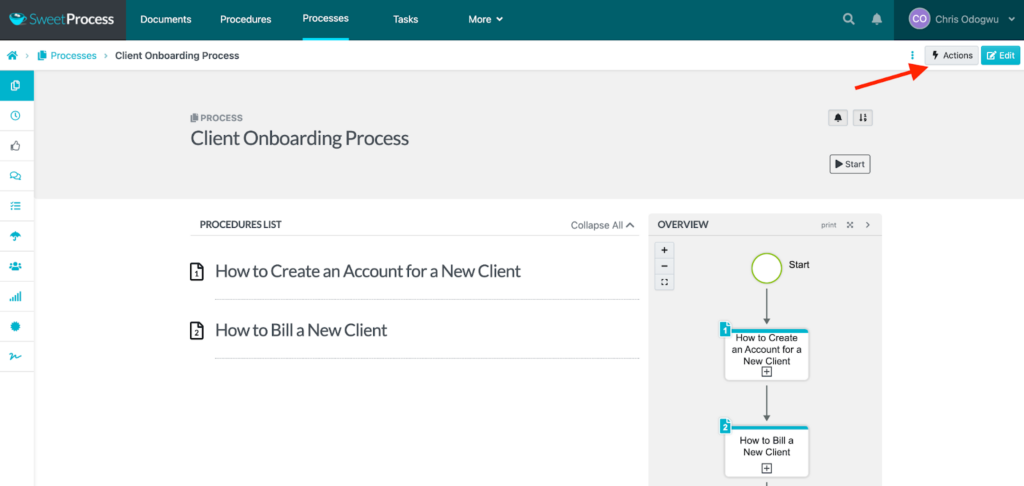
Select an action from the drop-down menu.
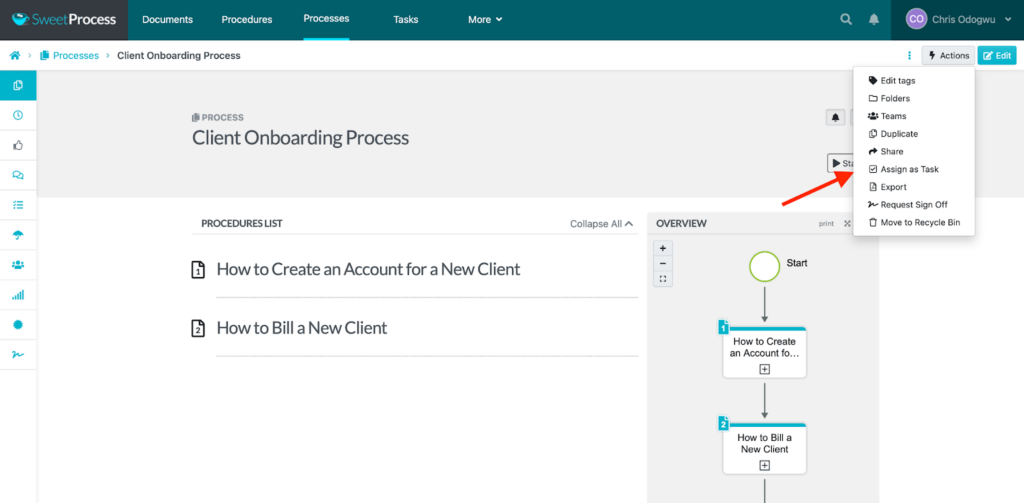
Click on “Assign” to assign tasks.
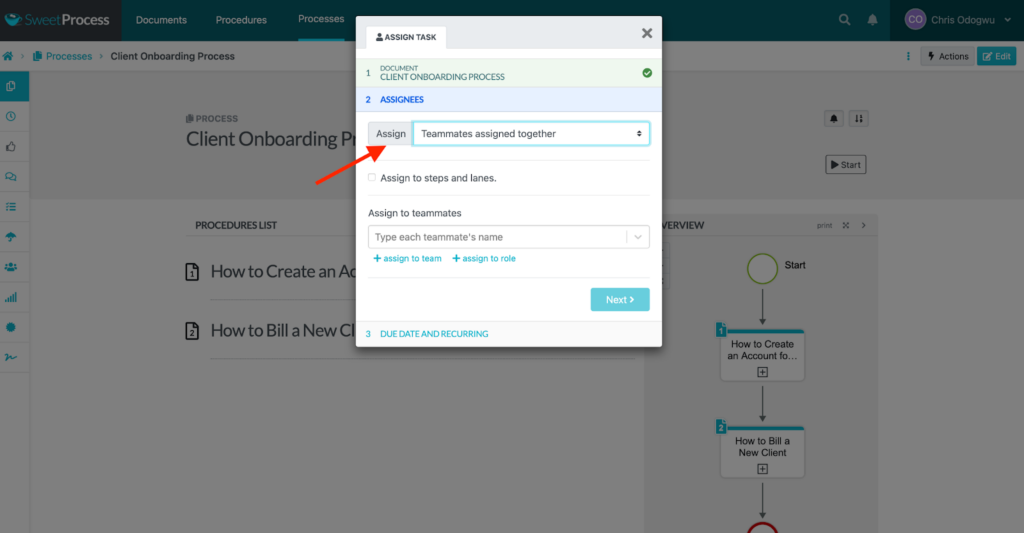
To assign the task to one person, click “Teammates assigned their task.”
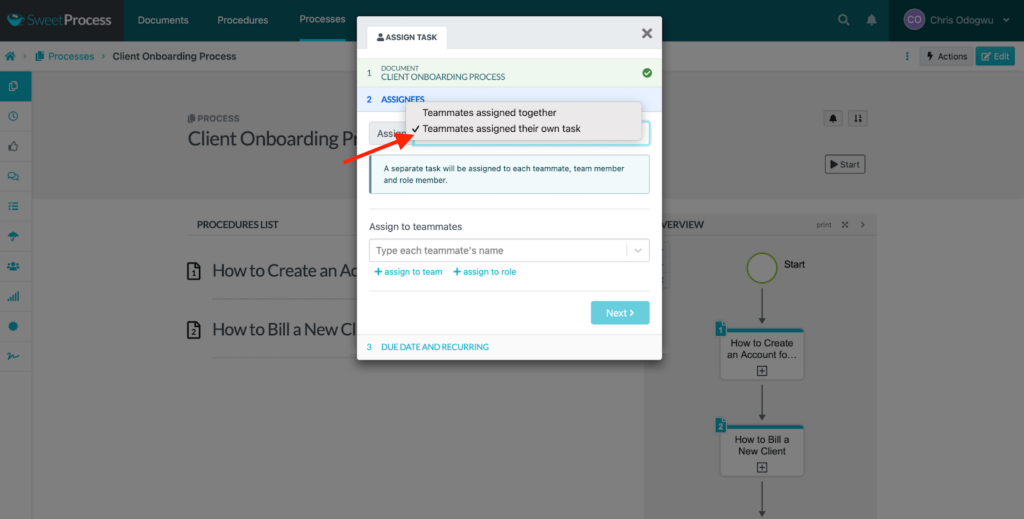
Select the teammate.
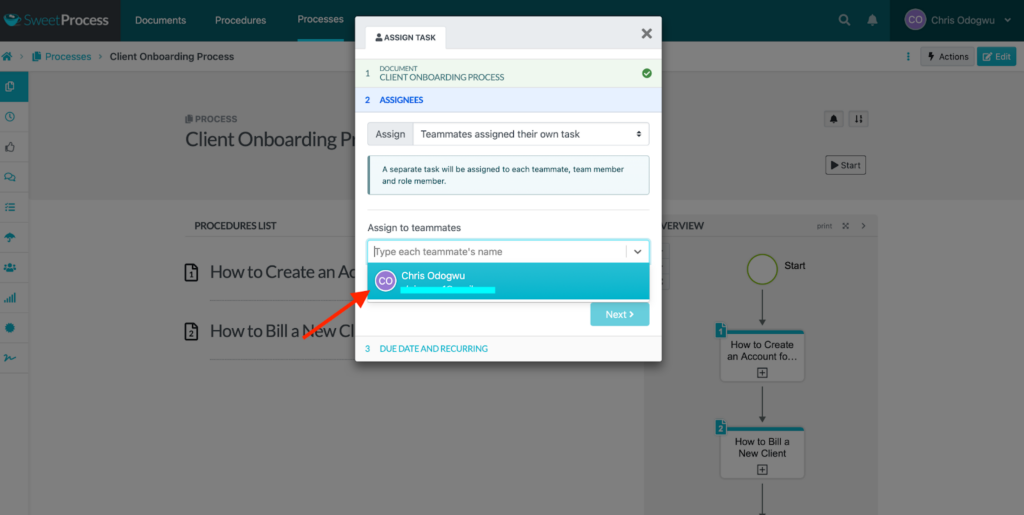
Enter the task name, due date, time, and frequency, and click “Assign Task.”
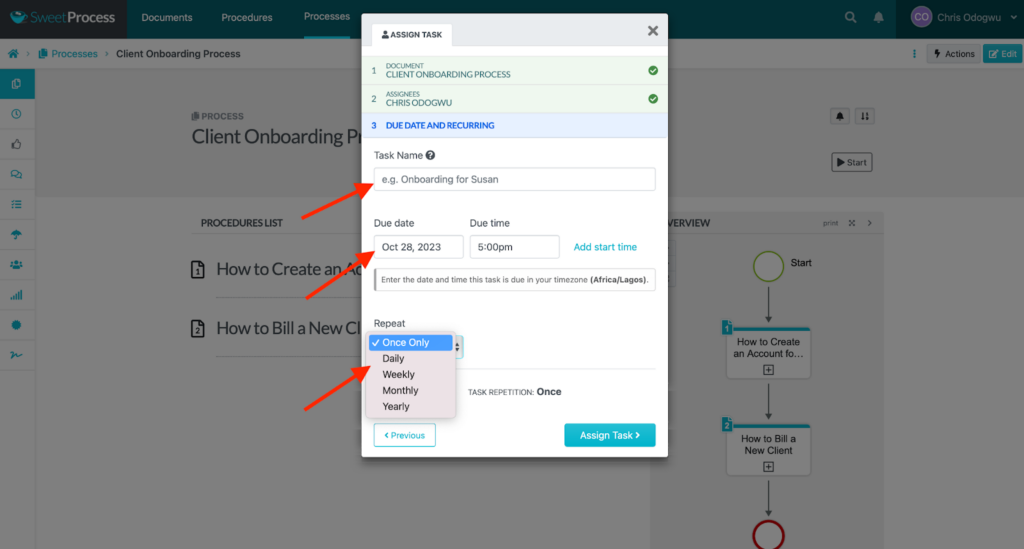
Team Collaboration in SweetProcess
Collaboration boosts organizational productivity by combining team members’ project expertise. SweetProcess makes it easy for employees to collaborate on projects with bespoke features to keep everyone updated on project progress.
How to Assign Collaborative Tasks in SweetProcess
Navigate to the document and click on “Actions.”
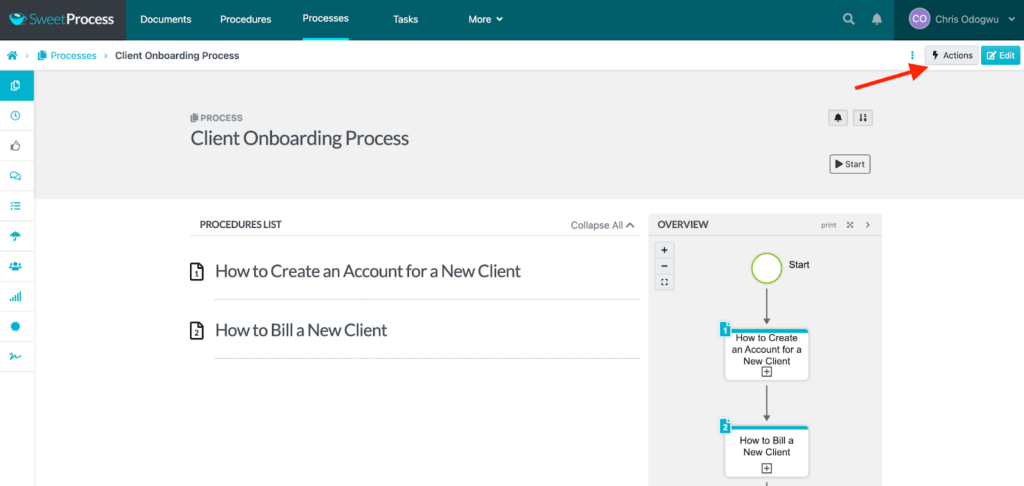
Select “Assign as Task” from the drop-down menu.
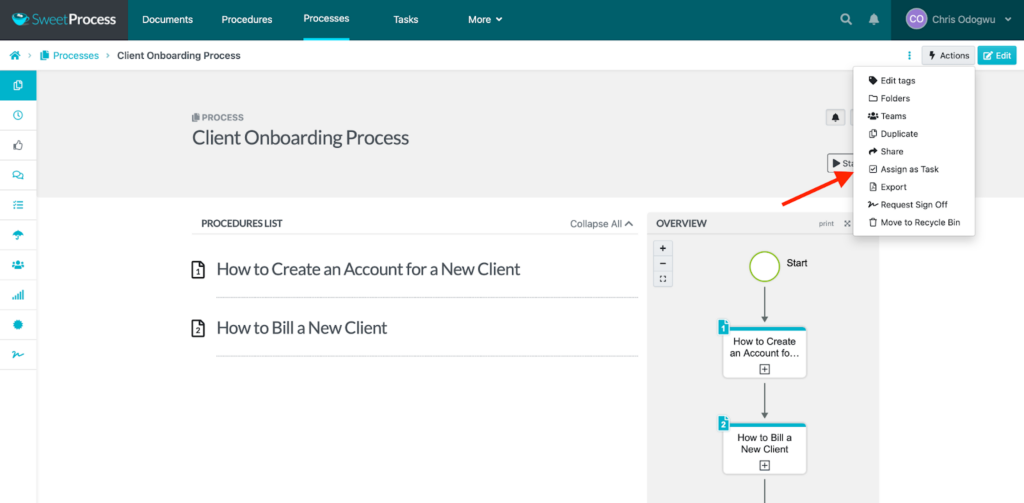
Select “Teammates assigned together” to assign it to multiple people.
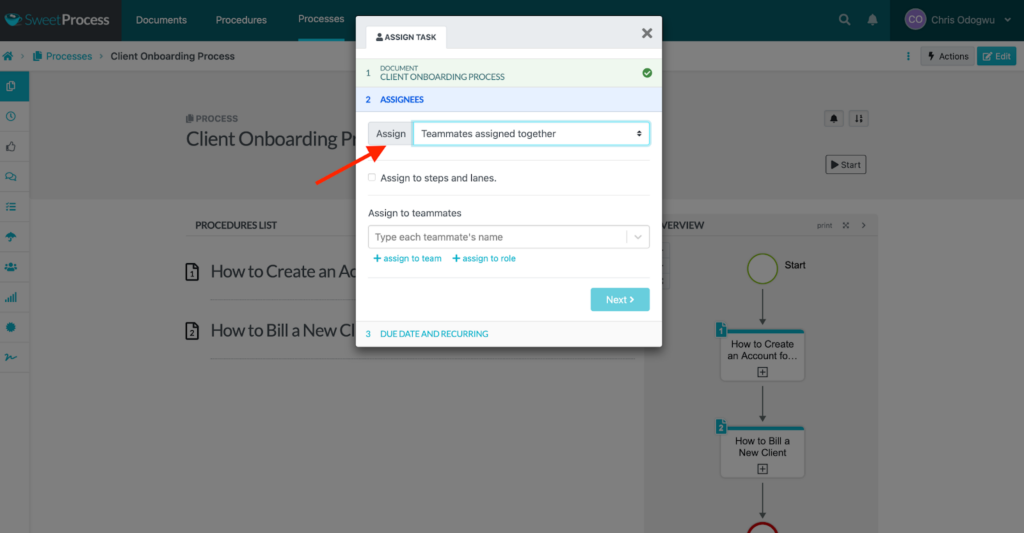
Jacob and Tom transformed their business operations by deciding to implement SweetProcess. The decision to train your employees with an effective software is yours to make.
5 Impressive Employee Training Examples You Can Copy
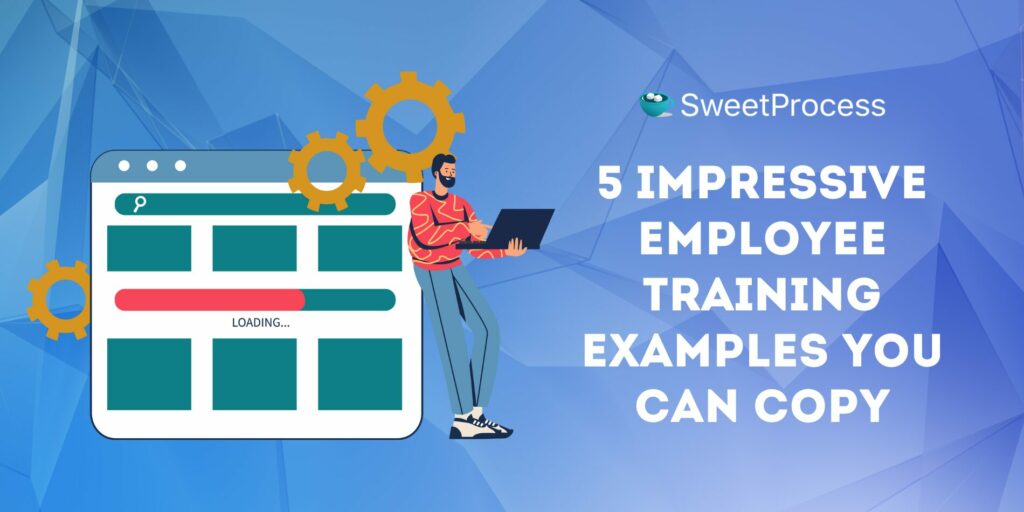
Standard employee training models provide continuous training success. Taking cues from those who have worked for others saves organizations the trouble of creating training frameworks from scratch. The following employee training examples are proven and tested.
Cooley Academy Mentoring Program
The Cooley Academy Mentoring Program (CAMP) is a mentorship initiative by California-based law firm Cooley. Having suffered a huge setback in its operations, the organization hired recent graduates and paired them with legal experts for mentorship. The new intakes had one-on-one intensive training sessions with their mentors, learning critical skills in the legal profession, and their performance increased by 95% within a short time.
Facebook Engineering Bootcamp
The Facebook Engineering Bootcamp is a six- to eight-week program that trains new engineers on the Facebook code base. The trainees are mentored by expert engineers who teach them how to tackle regular engineering problems on the site. After the first few weeks of training, the new engineers are assigned to fix bugs on the social network, and most of them perform well.
Amazon Technical Academy
Amazon Technical Academy is an upskilling employee training program that helps non-technical Amazon employees transition into technical roles. As part of their assessments, the participants are trained by senior software engineers to resolve real technical problems. The trainees continue with their current roles while participating in the nine-month program. Successful candidates transition into software engineers at the end of the training.
Google’s G2G Network
Google’s G2G Network is a peer training initiative where Google employees teach and learn from one another. Employees who are experts in their fields volunteer to share their knowledge with others by teaching courses and offering individual mentorship. Over 6,000 Google employees are members of the G2G network, many attributing their improved performance to the platform.
GE Brilliant You
GE Brilliant You is a virtual learning platform for training GE employees. It offers a knowledge base for employees to access information to perform their duties better. The GE curriculum is designed to meet employee needs in a digital business landscape and acquaint them with various digital tools.
A common factor among these employee training examples is remote learning. You can use SweetProcess to train your workers remotely, building a solid team without geographical restrictions.
8 Tips and Best Practices for Effective Employee Training
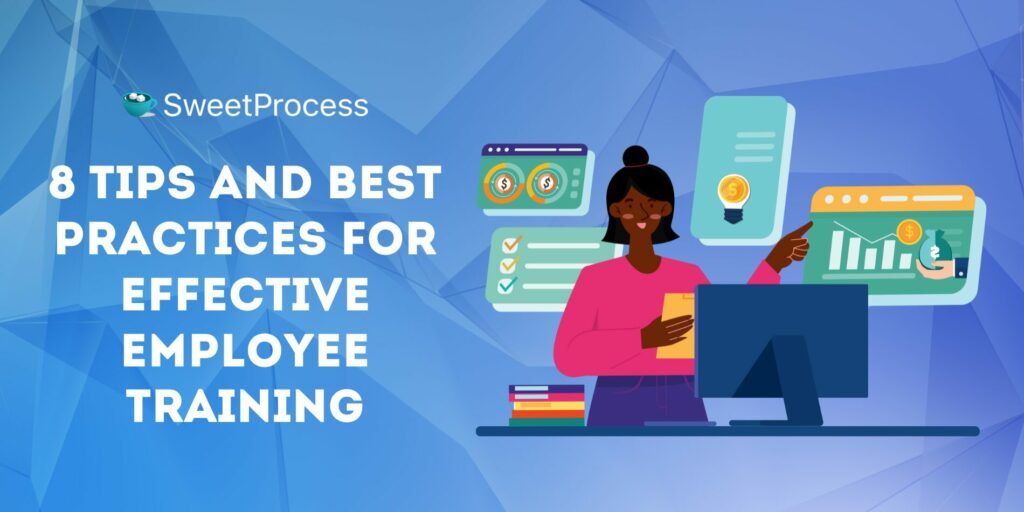
The effectiveness of employee training lies in its ability to promote efficiency and increase performance. Anything less is a waste of valuable time and resources. Here are some practices to make it worthwhile.
Embrace Digital and Mobile Learning
An IBM study states that every dollar spent on digital learning for employees yields $30 in productivity because they learn faster. Flexibility is a prerequisite for effective training, especially in a digitally-focused marketplace. Creating online training materials that employees can access remotely prevents physical barriers unless the task requires physical presence. Such flexibility allows participants to self-learn wherever and whenever.
Incorporate Experiential Learning
Experiential learning helps employees acquire practical skills to perform tasks in real-life situations by showing them how to perform tasks and encouraging them to try activities during training. This resolves knowledge and skill issues that only arise in real-case scenarios.
Create Interactive Training Content
Interactive training material increases audience participation and retention. Avoid a one-way training model, as this may bore participants. Combining various elements such as video, audio, and chart instead of using only text reduces boredom. Ask employees to engage with the training material to keep them active.
Leverage Employee Training Software
Employee training software is designed to simplify and enhance training. It gives a head start with customized features to prevent creating training content from scratch. Users can import documents, access templates, and customize design interfaces to suit their needs.
Measure Training Effectiveness with Employee Surveys and Quizzes
Repeating ineffective training is a continuous waste of resources and reduces employees’ interest in training within the organization. Gauge the impact of concluded training with surveys and quizzes. Make them anonymous so that participants can give honest feedback.
Provide a Personalized and Flexible Learning Experience
Training participants’ knowledge and skills vary. Factoring this discrepancy in training produces a more rewarding learning experience. Assess employees’ capacities ahead of time and engage them personally to meet their needs.
Align Training With Organizational Goals
Aligning employee training with organizational goals is good resource management practice. Training employees in areas outside of your business needs is not prudent because the knowledge and skills they acquire will not be impactful in your business. Create the training around your immediate business needs for quick returns on investment.
Engage Subject Matter Experts
Employees must be able to apply the knowledge and skills they are taught in training to real business problems to record performance success. This is possible when professionals facilitate employee training. Engage subject matter experts with a track record in the chosen areas to headline the training.
Maximize the opportunity by taking advantage of SweetProcess’ multimedia features to create comprehensive standard operating procedures around the experts’ knowledge for longevity.
7 Employee Training Trends for 2025 and Beyond

Employee training methods evolve according to trends in business environments, particularly innovations in digital technology. Identifying and aligning employee training with top trends enables organizations to maximize their training endeavors. Here are seven key employee training trends for 2025 and beyond.
Use of Advanced Technologies
In 2025, advanced technologies such as generative AI, virtual reality training, and gamification of learning will thrive in employee training. Organizations can use these technologies to streamline training by creating content instantly with generative AI, enhancing remote learning with virtual reality, and increasing employee engagement with gaming of learning.
Peer Training
Peer training is gaining momentum in mainstream business. With Google’s G2G Network recording a high success rate, more organizations will likely leverage peer training in 2025. Encourage peer training by cultivating a healthy and inclusive work culture where employees are keen on contributing to organizational growth.
Video Training
Video training may not be new. However, new features, such as interactive learning, are being incorporated for greater value. Employees can engage with different components of a training video by clicking on the screen to navigate to choice items.
Blended Learning
Although digital learning offers several benefits, like flexibility and convenience, traditional learning still has that in-person advantage. Some tasks are best understood when taught or practiced in person. Blended learning combines both digital tools and face-to-face interactions to offer a holistic learning experience.
Hybrid Work
Organizations may never return to the complete in-person work practice obtainable before COVID-19 as hybrid work continues to be popular in 2025. Therefore, it is important to create flexible employee training to accommodate in-person and remote learning based on training needs and participants’ convenience.
Microlearning
The human attention span is getting shorter as commitments and distractions increase. Break training materials into small parts as employees may easily lose interest in long-form content. Focus on a specific subject or skill and communicate it quickly for faster assimilation.
Cybersecurity Training
The rising use of technology in the workplace creates more vulnerabilities. There is an urgent need to heighten cybersecurity training because cybercriminals can hack a business network with the smallest loophole. Educating employees on healthy cybersecurity practices can prevent risks.
Raise the bar by documenting cybersecurity practices and making them accessible in SweetProcess to employees at all levels.
Train Your New Employees Effectively Using SweetProcess
An Association for Talent Development (ATD) report reveals that organizations with effective employee training record 218% higher income per employee compared to those who do not. This proves that employee training is an organization’s biggest investment. SweetProcess can help you train your employees to achieve such success without hassle.
Frequently Asked Questions (FAQs) About Employee Training
Employee training is an organization’s effort to give employees the skills they need to be successful in their current roles, while employee development is a long-term commitment aimed at nurturing employees’ career advancement. Continuous employee training leads to employee development.
There is no standard duration for employee training. The length of training depends on the job role and tasks. Typically, employee training on specific roles or tasks lasts from a few hours to a few months, depending on the training syllables.
All active employees, whether new or established, need training. Employees who are good at their job can also be trained to be better.
Yes, training improves employee productivity by teaching employees skills to perform their duties better, faster, and more efficiently.
Continuous learning helps businesses compete favorably in the market by keeping them updated with emerging practices. It also increases productivity, boosts employee performance, and increases retention.


